SKODA OCTAVIA 2011 2.G / (1Z) Manual Online
Manufacturer: SKODA, Model Year: 2011, Model line: OCTAVIA, Model: SKODA OCTAVIA 2011 2.G / (1Z)Pages: 248, PDF Size: 3.79 MB
Page 81 of 248
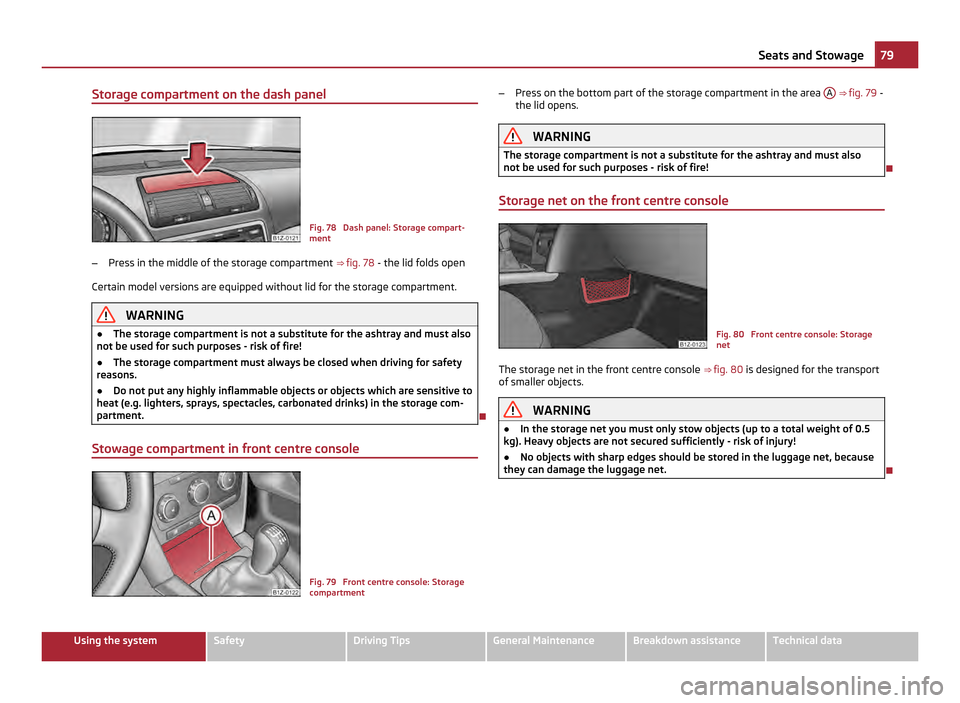
Storage compartment on the dash panel
Fig. 78 Dash panel: Storage compart-
ment
– Press in the middle of the storage compartment ⇒ fig. 78 - the lid folds open
Certain model versions are equipped without lid for the storage compartment. WARNING
● The storage compartment is not a substitute for the ashtray and must also
not be used for such purposes - risk of fire!
● The storage compartment must always be closed when driving for safety
reasons.
● Do not put any highly inflammable objects or objects which are sensitive to
heat (e.g. lighters, sprays, spectacles, carbonated drinks) in the storage com-
partment.
Stowage compartment in front centre console Fig. 79 Front centre console: Storage
compartment–
Press on the bottom part of the storage compartment in the area A ⇒
fig. 79 -
the lid opens. WARNING
The storage compartment is not a substitute for the ashtray and must also
not be used for such purposes - risk of fire!
Storage net on the front centre console Fig. 80 Front centre console: Storage
net
The storage net in the front centre console ⇒ fig. 80 is designed for the transport
of smaller objects. WARNING
● In the storage net you must only stow objects (up to a total weight of 0.5
kg). Heavy objects are not secured sufficiently - risk of injury!
● No objects with sharp edges should be stored in the luggage net, because
they can damage the luggage net. 79
Seats and Stowage Using the system Safety Driving Tips General Maintenance Breakdown assistance Technical data
Page 82 of 248
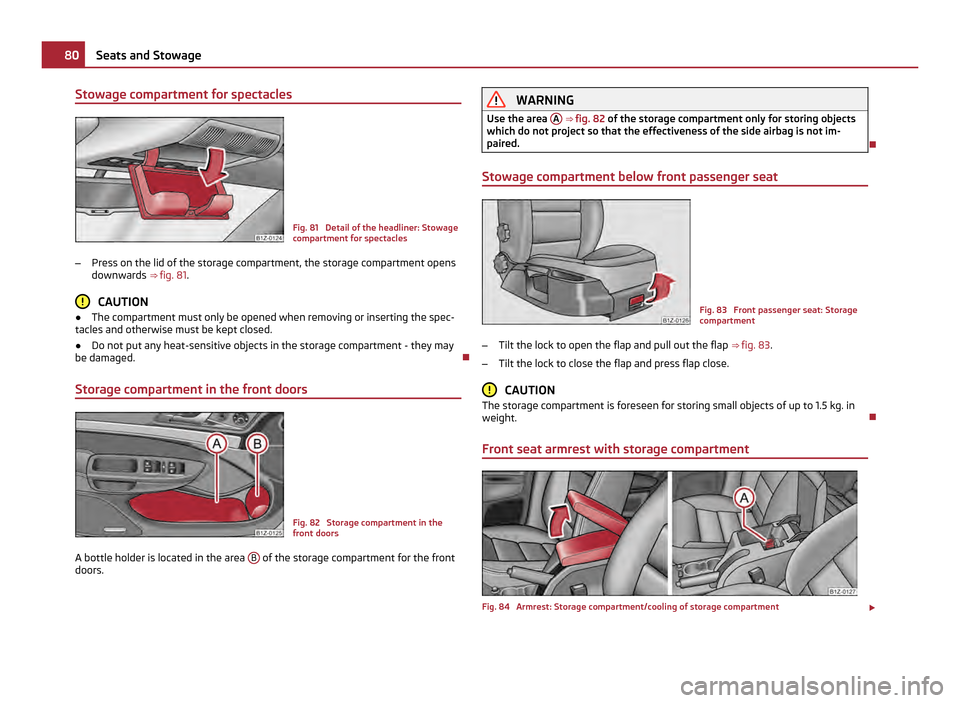
Stowage compartment for spectacles
Fig. 81 Detail of the headliner: Stowage
compartment for spectacles
– Press on the lid of the storage compartment, the storage compartment opens
downwards ⇒ fig. 81 . CAUTION
● The compartment must only be opened when removing or inserting the spec-
tacles and otherwise must be kept closed.
● Do not put any heat-sensitive objects in the storage compartment - they may
be damaged.
Storage compartment in the front doors Fig. 82 Storage compartment in the
front doors
A bottle holder is located in the area B of the storage compartment for the front
doors. WARNING
Use the area A ⇒ fig. 82 of the storage compartment only for storing objects
which do not project so that the effectiveness of the side airbag is not im-
paired.
Stowage compartment below front passenger seat Fig. 83 Front passenger seat: Storage
compartment
– Tilt the lock to open the flap and pull out the flap ⇒ fig. 83 .
– Tilt the lock to close the flap and press flap close. CAUTION
The storage compartment is foreseen for storing small objects of up to 1.5 kg. in
weight.
Front seat armrest with storage compartment Fig. 84 Armrest: Storage compartment/cooling of storage compartment
£80
Seats and Stowage
Page 83 of 248
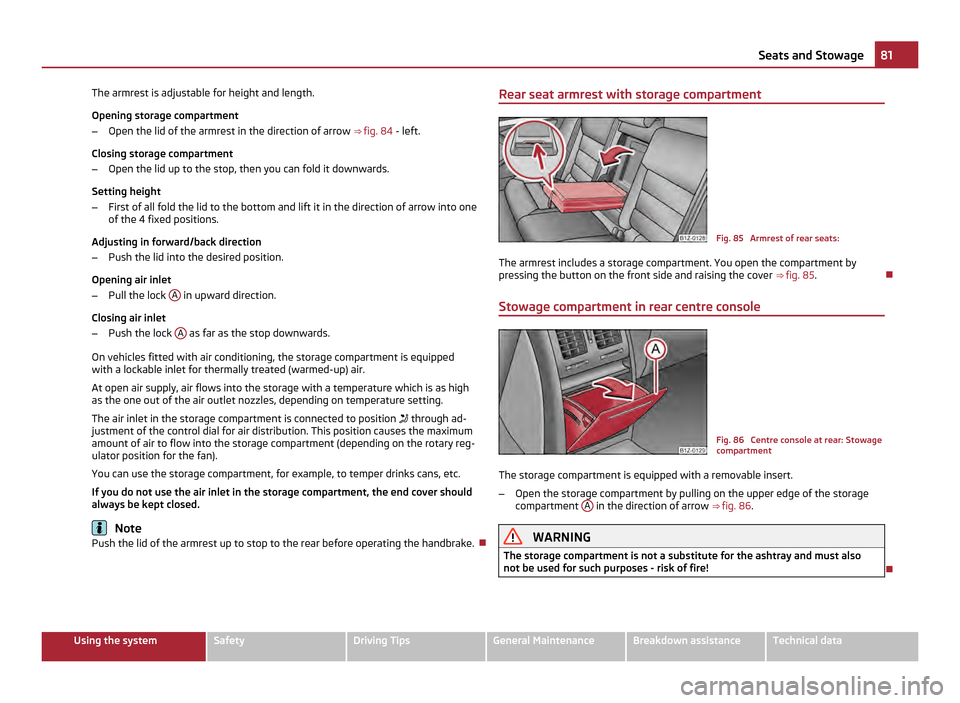
The armrest is adjustable for height and length.
Opening storage compartment
–
Open the lid of the armrest in the direction of arrow ⇒ fig. 84 - left.
Closing storage compartment
– Open the lid up to the stop, then you can fold it downwards.
Setting height
– First of all fold the lid to the bottom and lift it in the direction of arrow into one
of the 4 fixed positions.
Adjusting in forward/back direction
– Push the lid into the desired position.
Opening air inlet
– Pull the lock A in upward direction.
Closing air inlet
– Push the lock A as far as the stop downwards.
On vehicles fitted with air conditioning, the storage compartment is equipped
with a lockable inlet for thermally treated (warmed-up) air.
At open air supply, air flows into the storage with a temperature which is as high
as the one out of the air outlet nozzles, depending on temperature setting.
The air inlet in the storage compartment is connected to position through ad-
justment of the control dial for air distribution. This position causes the maximum
amount of air to flow into the storage compartment (depending on the rotary reg-
ulator position for the fan).
You can use the storage compartment, for example, to temper drinks cans, etc.
If you do not use the air inlet in the storage compartment, the end cover should
always be kept closed. Note
Push the lid of the armrest up to stop to the rear before operating the handbrake. Rear seat armrest with storage compartment
Fig. 85 Armrest of rear seats:
The armrest includes a storage compartment. You open the compartment by
pressing the button on the front side and raising the cover ⇒
fig. 85 .
Stowage compartment in rear centre console Fig. 86 Centre console at rear: Stowage
compartment
The storage compartment is equipped with a removable insert.
– Open the storage compartment by pulling on the upper edge of the storage
compartment A in the direction of arrow
⇒ fig. 86 . WARNING
The storage compartment is not a substitute for the ashtray and must also
not be used for such purposes - risk of fire! 81
Seats and Stowage Using the system Safety Driving Tips General Maintenance Breakdown assistance Technical data
Page 84 of 248

Seat backrest with opening for skis
Fig. 87 Rear seats: Handle of lid/luggage compartment: Unlock button
After folding open the armrest and the lid, an opening in the seat backrest be-
comes visible through which you can push the removable through-loading bag
with skis. You can fold open the armrest and the lid from the passenger or lug-
gage compartment.
Opening from passenger compartment
– Fold down the armrest of the rear seat at the loop ⇒ page 66.
– Pull the handle up to the stop in upward direction and fold open the lid down-
wards ⇒
fig. 87 - left.
Opening from luggage compartment
– Push the unlock button downwards ⇒
fig. 87 - right and fold the lid (with arm-
rest) to the front.
Closing
– Fold the lid and the armrest up to the stop in upward direction - the lid must
click into place audibly.
Ensure that the armrest is always locked into place after closing. You can recog-
nize this on the fact that the red field above the unlocking button A of the lug-
gage compartment is not visible. WARNING
The opening for the skis is solely used for transporting skis which are placed
in a properly secured removable through-loading bag ⇒
page 82. Through-loading bag The removable through-loading bag is solely used for transporting
skis. Fig. 88 Securing the removable
through-loading bag
Loading
– Open the boot lid/luggage compartment door.
– Fold the rear armrest and the cover in the seat backrest downwards
⇒ page 82, Seat backrest with opening for skis
.
– Place the empty removable through-loading bag in such a way that the end of
the bag with the zip lies in the boot.
– Push the skis into the removable through-loading bag from the luggage com-
partment ⇒ .
Securing
– Tighten the strap A on the free end around the skis in front of the bindings
⇒ fig. 88 .
– Fold the seat backrest a little forward.
– Guide the securing strap B through the opening in the seat backrest around
the upper part of the seat backrest.
– Then push the seat backrest back into the upright position until the locking
button clicks into place - check by pulling on the seat backrest.
– Insert the securing strap B into the lock
C until it is heard to lock in place.
On vehicles fitted with a luggage net partition, guide the securing strap B around
the housing when the net partition is rolled up. After fixing the luggage net parti-
tion in place, it is not longer possible to unroll the luggage net partition. £82
Seats and Stowage
Page 85 of 248
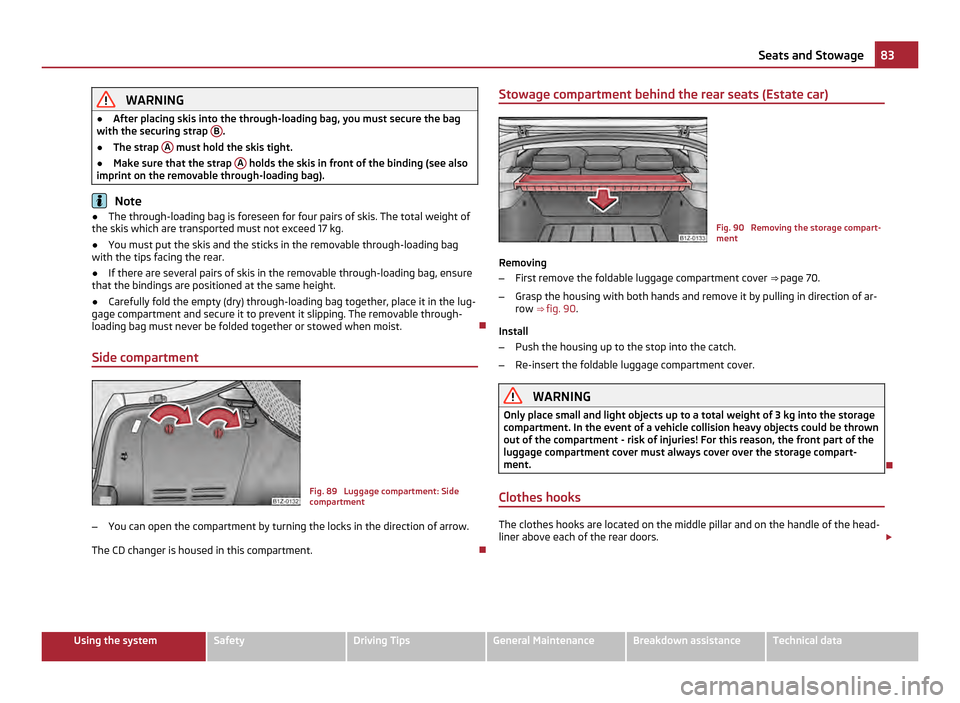
WARNING
● After placing skis into the through-loading bag, you must secure the bag
with the securing strap B .
● The strap A must hold the skis tight.
● Make sure that the strap A holds the skis in front of the binding (see also
imprint on the removable through-loading bag). Note
● The through-loading bag is foreseen for four pairs of skis. The total weight of
the skis which are transported must not exceed 17 kg.
● You must put the skis and the sticks in the removable through-loading bag
with the tips facing the rear.
● If there are several pairs of skis in the removable through-loading bag, ensure
that the bindings are positioned at the same height.
● Carefully fold the empty (dry) through-loading bag together, place it in the lug-
gage compartment and secure it to prevent it slipping. The removable through-
loading bag must never be folded together or stowed when moist.
Side compartment Fig. 89 Luggage compartment: Side
compartment
– You can open the compartment by turning the locks in the direction of arrow.
The CD changer is housed in this compartment. Stowage compartment behind the rear seats (Estate car)
Fig. 90 Removing the storage compart-
ment
Removing
– First remove the foldable luggage compartment cover ⇒ page 70.
– Grasp the housing with both hands and remove it by pulling in direction of ar-
row ⇒ fig. 90 .
Install
– Push the housing up to the stop into the catch.
– Re-insert the foldable luggage compartment cover. WARNING
Only place small and light objects up to a total weight of 3 kg into the storage
compartment. In the event of a vehicle collision heavy objects could be thrown
out of the compartment - risk of injuries! For this reason, the front part of the
luggage compartment cover must always cover over the storage compart-
ment.
Clothes hooks The clothes hooks are located on the middle pillar and on the handle of the head-
liner above each of the rear doors.
£ 83
Seats and Stowage Using the system Safety Driving Tips General Maintenance Breakdown assistance Technical data
Page 86 of 248
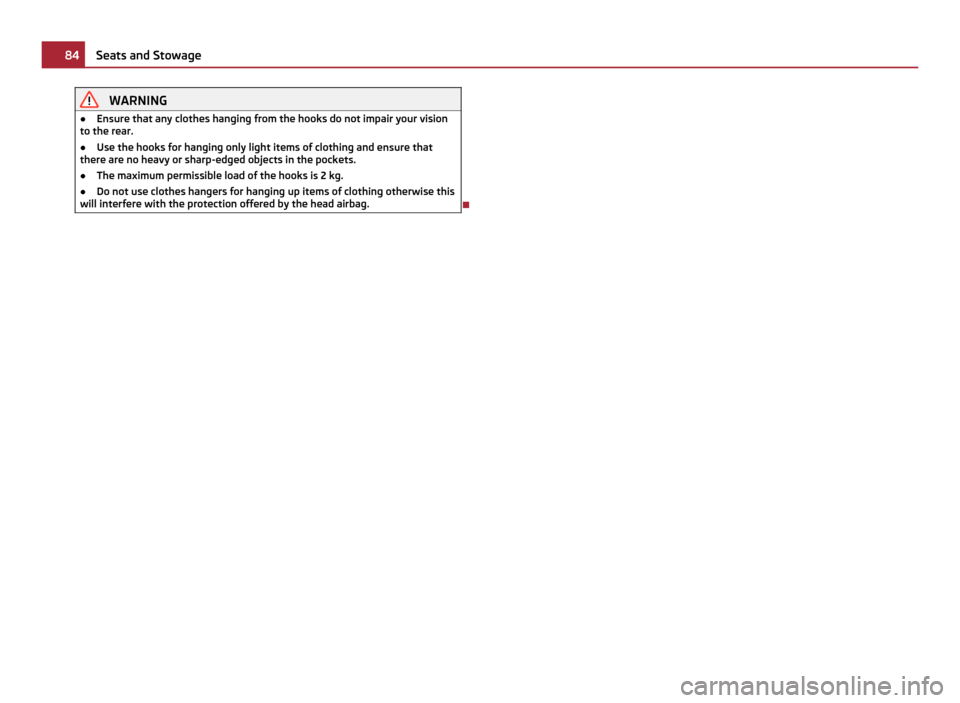
WARNING
● Ensure that any clothes hanging from the hooks do not impair your vision
to the rear.
● Use the hooks for hanging only light items of clothing and ensure that
there are no heavy or sharp-edged objects in the pockets.
● The maximum permissible load of the hooks is 2 kg.
● Do not use clothes hangers for hanging up items of clothing otherwise this
will interfere with the protection offered by the head airbag. 84
Seats and Stowage
Page 87 of 248
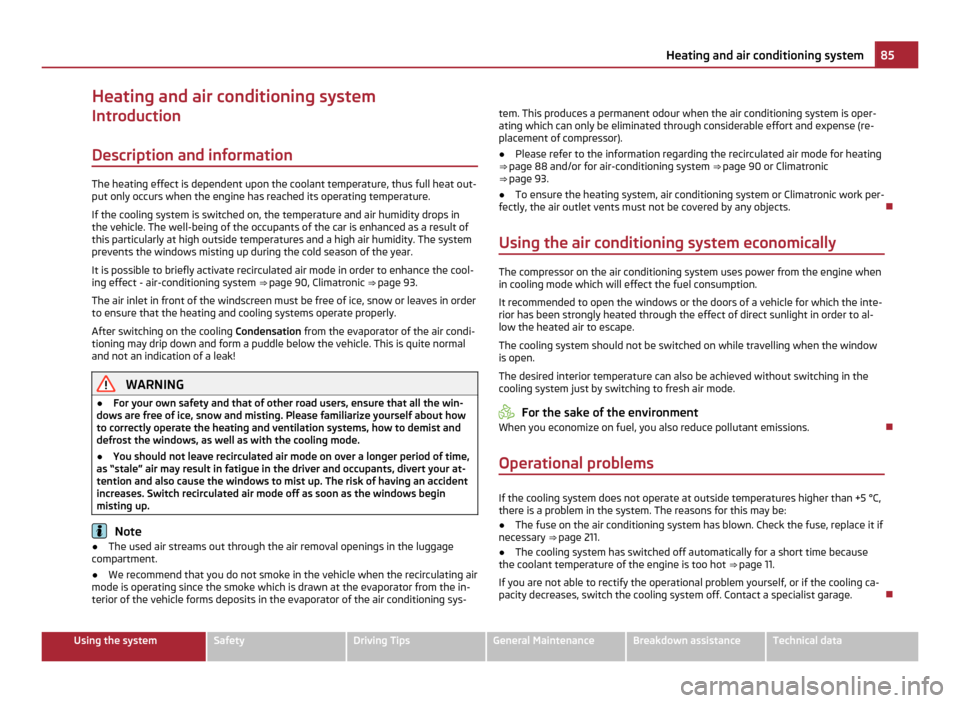
Heating and air conditioning system
Introduction
Description and information The heating effect is dependent upon the coolant temperature, thus full heat out-
put only occurs when the engine has reached its operating temperature.
If the cooling system is switched on, the temperature and air humidity drops in
the vehicle. The well-being of the occupants of the car is enhanced as a result of
this particularly at high outside temperatures and a high air humidity. The system
prevents the windows misting up during the cold season of the year.
It is possible to briefly activate recirculated air mode in order to enhance the cool-
ing effect - air-conditioning system ⇒ page 90
, Climatronic ⇒ page 93.
The air inlet in front of the windscreen must be free of ice, snow or leaves in order
to ensure that the heating and cooling systems operate properly.
After switching on the cooling Condensation from the evaporator of the air condi-
tioning may drip down and form a puddle below the vehicle. This is quite normal
and not an indication of a leak! WARNING
● For your own safety and that of other road users, ensure that all the win-
dows are free of ice, snow and misting. Please familiarize yourself about how
to correctly operate the heating and ventilation systems, how to demist and
defrost the windows, as well as with the cooling mode.
● You should not leave recirculated air mode on over a longer period of time,
as
“stale” air may result in fatigue in the driver and occupants, divert your at-
tention and also cause the windows to mist up. The risk of having an accident
increases. Switch recirculated air mode off as soon as the windows begin
misting up. Note
● The used air streams out through the air removal openings in the luggage
compartment.
● We recommend that you do not smoke in the vehicle when the recirculating air
mode is operating since the smoke which is drawn at the evaporator from the in-
terior of the vehicle forms deposits in the evaporator of the air conditioning sys- tem. This produces a permanent odour when the air conditioning system is oper-
ating which can only be eliminated through considerable effort and expense (re-
placement of compressor).
● Please refer to the information regarding the recirculated air mode for heating
⇒
page 88 and/or for air-conditioning system ⇒ page 90 or Climatronic
⇒ page 93.
● To ensure the heating system, air conditioning system or Climatronic work per-
fectly, the air outlet vents must not be covered by any objects.
Using the air conditioning system economically The compressor on the air conditioning system uses power from the engine when
in cooling mode which will effect the fuel consumption.
It recommended to open the windows or the doors of a vehicle for which the inte-
rior has been strongly heated through the effect of direct sunlight in order to al-
low the heated air to escape.
The cooling system should not be switched on while travelling when the window
is open.
The desired interior temperature can also be achieved without switching in the
cooling system just by switching to fresh air mode. For the sake of the environment
When you economize on fuel, you also reduce pollutant emissions.
Operational problems If the cooling system does not operate at outside temperatures higher than +5 °C,
there is a problem in the system. The reasons for this may be:
●
The fuse on the air conditioning system has blown. Check the fuse, replace it if
necessary ⇒ page 211.
● The cooling system has switched off automatically for a short time because
the coolant temperature of the engine is too hot ⇒ page 11.
If you are not able to rectify the operational problem yourself, or if the cooling ca-
pacity decreases, switch the cooling system off. Contact a specialist garage. 85
Heating and air conditioning system Using the system Safety Driving Tips General Maintenance Breakdown assistance Technical data
Page 88 of 248
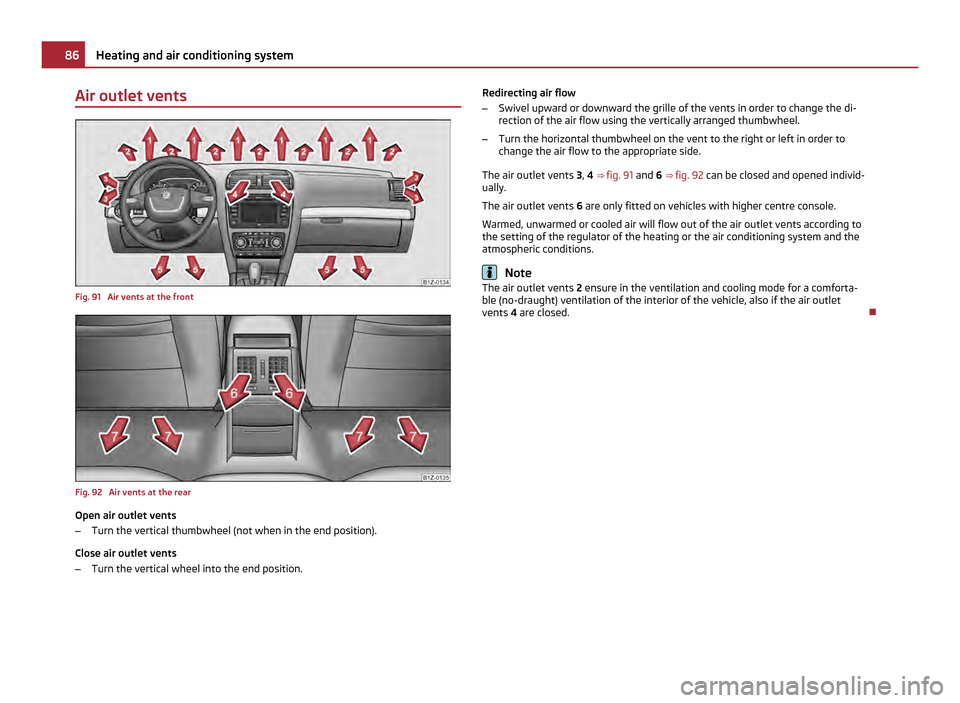
Air outlet vents
Fig. 91 Air vents at the front
Fig. 92 Air vents at the rear
Open air outlet vents
–
Turn the vertical thumbwheel (not when in the end position).
Close air outlet vents
– Turn the vertical wheel into the end position. Redirecting air flow
–
Swivel upward or downward the grille of the vents in order to change the di-
rection of the air flow using the vertically arranged thumbwheel.
– Turn the horizontal thumbwheel on the vent to the right or left in order to
change the air flow to the appropriate side.
The air outlet vents 3, 4 ⇒
fig. 91 and 6 ⇒ fig. 92 can be closed and opened individ-
ually.
The air outlet vents 6 are only fitted on vehicles with higher centre console.
Warmed, unwarmed or cooled air will flow out of the air outlet vents according to
the setting of the regulator of the heating or the air conditioning system and the
atmospheric conditions. Note
The air outlet vents 2 ensure in the ventilation and cooling mode for a comforta-
ble (no-draught) ventilation of the interior of the vehicle, also if the air outlet
vents 4 are closed. 86
Heating and air conditioning system
Page 89 of 248
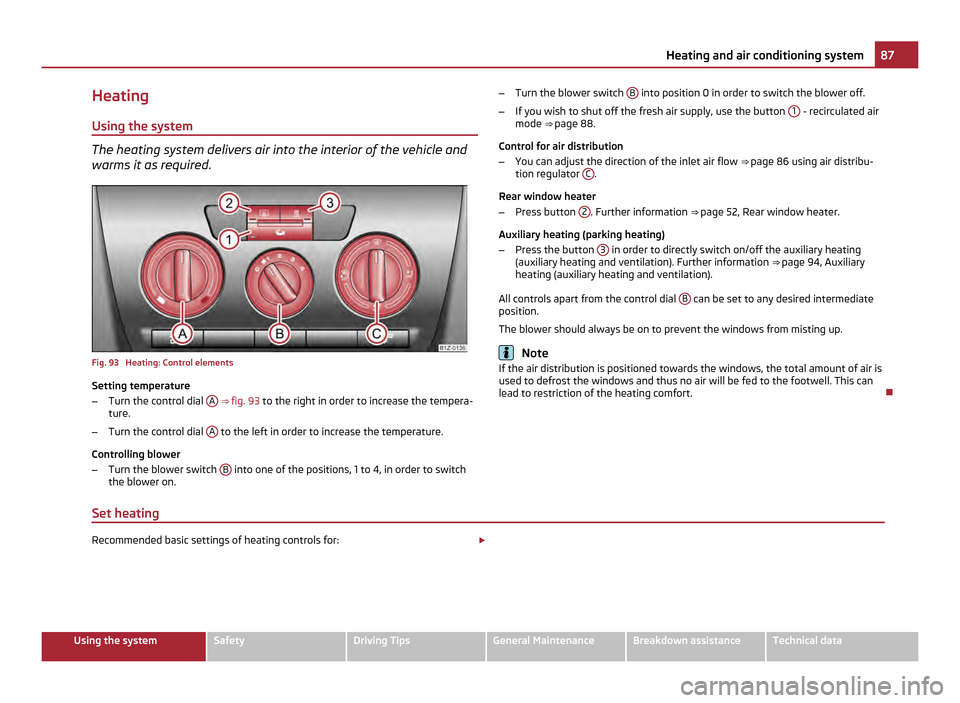
Heating
Using the system The heating system delivers air into the interior of the vehicle and
warms it as required.
Fig. 93 Heating: Control elements
Setting temperature
–
Turn the control dial A
⇒ fig. 93 to the right in order to increase the tempera-
ture.
– Turn the control dial A to the left in order to increase the temperature.
Controlling blower
– Turn the blower switch B into one of the positions, 1 to 4, in order to switch
the blower on. –
Turn the blower switch B into position 0 in order to switch the blower off.
– If you wish to shut off the fresh air supply, use the button 1 - recirculated air
mode ⇒ page 88
.
Control for air distribution
– You can adjust the direction of the inlet air flow ⇒
page 86 using air distribu-
tion regulator C .
Rear window heater
– Press button 2 . Further information
⇒ page 52, Rear window heater
.
Auxiliary heating (parking heating)
– Press the button 3 in order to directly switch on/off the auxiliary heating
(auxiliary heating and ventilation). Further information ⇒
page 94, Auxiliary
heating (auxiliary heating and ventilation).
All controls apart from the control dial B can be set to any desired intermediate
position.
The blower should always be on to prevent the windows from misting up. Note
If the air distribution is positioned towards the windows, the total amount of air is
used to defrost the windows and thus no air will be fed to the footwell. This can
lead to restriction of the heating comfort.
Set heating Recommended basic settings of heating controls for:
£ 87
Heating and air conditioning system Using the system Safety Driving Tips General Maintenance Breakdown assistance Technical data
Page 90 of 248
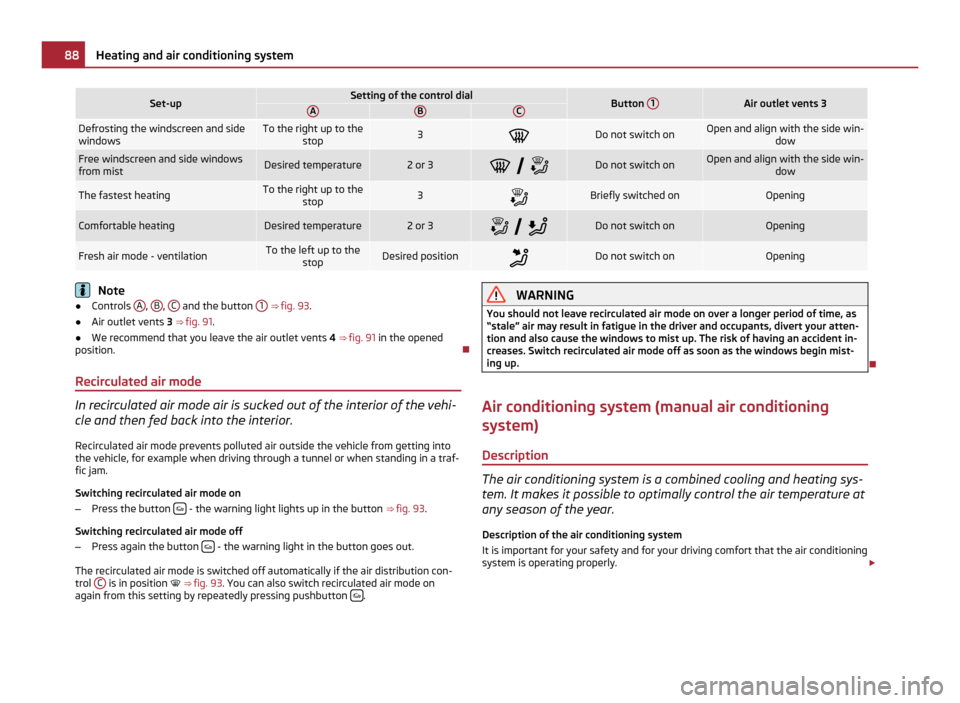
Set-up Setting of the control dial
Button
1 Air outlet vents 3
A B C
Defrosting the windscreen and side
windows To the right up to the
stop 3
Do not switch on Open and align with the side win-
dowFree windscreen and side windows
from mist
Desired temperature 2 or 3
Do not switch on Open and align with the side win-
dowThe fastest heating To the right up to the
stop 3
Briefly switched on Opening
Comfortable heating Desired temperature 2 or 3
Do not switch on Opening
Fresh air mode - ventilation To the left up to the
stop Desired position
Do not switch on Opening
Note
● Controls A ,
B ,
C and the button
1 ⇒ fig. 93
.
● Air outlet vents 3 ⇒ fig. 91.
● We recommend that you leave the air outlet vents 4 ⇒ fig. 91 in the opened
position.
Recirculated air mode In recirculated air mode air is sucked out of the interior of the vehi-
cle and then fed back into the interior.
Recirculated air mode prevents polluted air outside the vehicle from getting into
the vehicle, for example when driving through a tunnel or when standing in a traf-
fic jam.
Switching recirculated air mode on
– Press the button - the warning light lights up in the button
⇒ fig. 93 .
Switching recirculated air mode off
– Press again the button - the warning light in the button goes out.
The recirculated air mode is switched off automatically if the air distribution con-
trol C is in position
⇒ fig. 93. You can also switch recirculated air mode on
again from this setting by repeatedly pressing pushbutton . WARNING
You should not leave recirculated air mode on over a longer period of time, as
“stale
” air may result in fatigue in the driver and occupants, divert your atten-
tion and also cause the windows to mist up. The risk of having an accident in-
creases. Switch recirculated air mode off as soon as the windows begin mist-
ing up.
Air conditioning system (manual air conditioning
system) Description The air conditioning system is a combined cooling and heating sys-
tem. It makes it possible to optimally control the air temperature at
any season of the year.
Description of the air conditioning system
It is important for your safety and for your driving comfort that the air conditioning
system is operating properly. £88
Heating and air conditioning system